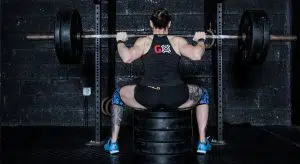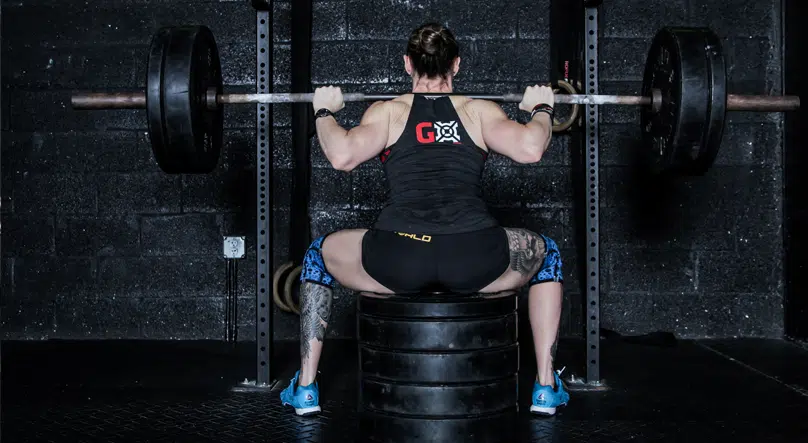Box squat have gotten very popular in the fitness community, but many people still seem confused about why you should be doing them and whether or not they’re safe.
With this article, we’ll address the most common misconceptions about box squats, starting with the question that probably first popped into your head when you saw this article’s title: Are box squats safe? If you want to learn more about why you should do box squats.
Box Squats are the Best Way to Train your Glutes
You might not be familiar with box squats or how they differ from traditional squats. But once you get a chance to try them, we think it’s safe to say that you’ll fall in love with them.
Unlike the regular squat, box squats take all of your bodyweights out of position and make it easier for more people to execute properly—even if their form is a little wonky on regular squats.
Even if you have access to a squat rack, consider adding box squats into your routine: A recent study found that they may be safer than barbell back squatting when it comes to muscle activity around your hip joints.
If you don’t have access to a box, consider elevating your squat with weight plates or even a sturdy step.
Box Squat Activate your Body’s Biggest Muscle
Your body has two primary muscle types: fast-twitch and slow-twitch. Slow-twitch muscles are attached to your bones via tendons.
This means that slow-twitch muscles help stabilize your body, keep it upright, and allow for strength but not necessarily explosive movement.
Fast-twitch muscles, on the other hand, only cross one joint and attach to a tendon as well as a muscle. These are responsible for explosive movements like jumping or sprinting.
The glutes fall under that category of fast-twitch muscles—meaning they help with things like jump squats (not powerlifting squats). However, fast-twitch muscle fibers don’t respond well to high loads (i.e., those over 60 percent of your 1RM), whereas slow-twitch fibers do.
Box Squats Give you Strong Legs
The act of box squatting has been proven to enhance one’s power output since it produces significant gains in both maximal strength and explosive strength.
The reason for that is simple: More force can be generated by a muscle when it is concentrically contracting against an immovable object (the box) than when it is being lengthened under a load.
Furthermore, research indicates that box squats can increase one’s maximum squat significantly more than regular barbell squats over time, making them an ideal tool for increasing your squat performance.
Combined with their ability to deliver results in significantly less time, they are among some of the most effective exercises around.
In fact, one study showed that performing box squats for 8 weeks was just as effective as regular barbell back squats for increasing one’s squat 1RM.
Box Squats Build Lower Body Strength
In addition to making your quads burn, box squats also build strength in your glutes and hamstrings. Research published in Human Movement Science found that box squats increased glute activity significantly more than regular squats.
Regular squatting, on the other hand, increased hamstring activity more than box squatting. Because these two muscles are some of your strongest muscles (glutes help with hip extension while hamstrings flex your knees), it’s a good idea to incorporate both exercises into your routine.
By strengthening these two groups of muscles, you improve overall lower body strength, helping you lift heavier weights when performing various leg exercises like lunges and leg presses.
Box Squats are Easy on your Joints
Let’s face it, weight training can be hard on your joints. And while they may seem innocuous, full squats can wreak havoc on knees—if they aren’t done correctly.
If a heavy bar rests across your upper back and neck during a squat, it’s only natural that your spine will round to compensate for its weight.
This could lead to injuries down the road. However, box squats move that pressure to your hip joint and off of your spine—reducing wear and tear over time.

Plus, they can help you get into better squat form. That’s because box squats force you to sit back in order to set up on top of a box that sits behind your heels—the same position as when performing a full squat with a loaded barbell.
Box Squats Allow More Weight on your Back
If box squats are new to your program, it might take some getting used to. The movement is unique, and it’s normal to struggle with balance at first.
But don’t let that hold you back! Performing box squats let you lift more weight than regular back squats.
That can translate into a greater load on your quads and hammies—the muscles responsible for knee-dominant exercises like box squats are approximately 67 percent faster to fatigue than their hip-dominant counterparts in traditional back squats, according to research published in the Journal of Strength & Conditioning Research. The added benefit? Better posture.
Box Squats Make Everything Else Easier
They teach proper squatting form, but they also teach good hip mobility. Once you start box squatting, your hips will feel more mobile and it’ll become easier to get into the proper position when squatting.
Plus, there’s less need for cueing—you won’t have to tell someone to sit back as much because they will feel their hips sink down as soon as they start to descend. When that happens, they instinctively know what they need to do next.
And once someone is in an ideal squat position with a decent amount of weight on their back—that means a lot fewer injuries, too. In fact, performing box squats regularly may even help reduce your chances of injury in any other lifts or athletic movements.
Even if someone has access to a barbell, they can still benefit from box squats. They teach proper squatting form and build strength and power more effectively because box squats are easier.
Box Squats Change Lives
I can’t say that for sure, but I can say that box squats have changed my life. More specifically, box squats have changed my squat game and given me a new love for training.
For those of you who are unfamiliar with box squats, they consist of squatting on a box rather than in a full-size squat rack.
Now before I go into detail about why box squats work better than conventional methods, there is one thing that we need to get out of the way—the name. I’m not sure what exactly it is about calling them box squats that makes people so uncomfortable.
Is it because people don’t think of dance as an athletic activity, or is it simply that people dislike changes in their routine? No matter what, if you can move past the strange name and try these, I can guarantee you’ll love them.
Are Box Squats any Good?
Squatting is an essential exercise for overall leg development. It works most of your lower body, helps build strength and muscle mass, can help improve balance and stability, and has even been shown to have heart health benefits.
But many lifters avoid squatting or use a limited range of motion because they feel it’s bad for their knees (and hips). While there are reasons that box squats can be beneficial when it comes to joint health (and avoiding injury), they also carry risk—it’s important to proceed with caution.
When done properly with strict form and under the supervision of a trained professional, box squats may actually be better for your joints than free-weight versions. Make sure you know all of your options before making any decisions about how to do box squats.
Why do People do High Box Squats?
Often, lifters choose to perform high box squats instead of regular full depth squats because they can utilize more weight than they could on a standard squat, and people like big weights.
The reasoning is that, by performing a high box squat, an individual will utilize greater leg strength because they need to overcome their own bodyweight from a higher point.
While it’s true that box squats allow for heavier weights, high box squats are not necessarily better for your legs than regular low-bar back squats. In fact, with regards to muscular development at least, both deep squatting and high box squatting can be just as effective if different muscles are targeted in each style of exercise.
This can make high box squats less effective than low-bar back squats for certain individuals, especially those who are not in need of greater leg strength.
Some lifters, such as powerlifters, may find that they have more luck performing deep squats instead of box squats when it comes to their respective sports because a large amount of force is required from their legs and hips during each lift.
In contrast, many Olympic weightlifters tend to perform high box squats regularly because it can help them utilize a wider range of motion for developing explosive power. High box squatting also tends to be more appropriate for people with bad knees because squatting from higher up allows them to decrease stress on their joints.
Why do Athletes do Box Squats?
READ MORE… Quick Ways To Get A Bigger Butt
Because they get faster and stronger, of course! The box squat places a premium on using your hips to drive weight up, which is a good skill to have.
The muscles involved in hip-hinging—the glutes and hamstrings—help drive up from a dead stop or when approaching top speed. But box squats aren’t just useful for running fast; they’re also useful for throwing hard or sprinting as explosively as possible.
If that sounds like a bodybuilder’s dream exercise, it kind of is: More power will help take you deeper into each set of squats, leg presses, and deadlifts for bigger, more ridiculous sets of reps. And all athletes want that.
